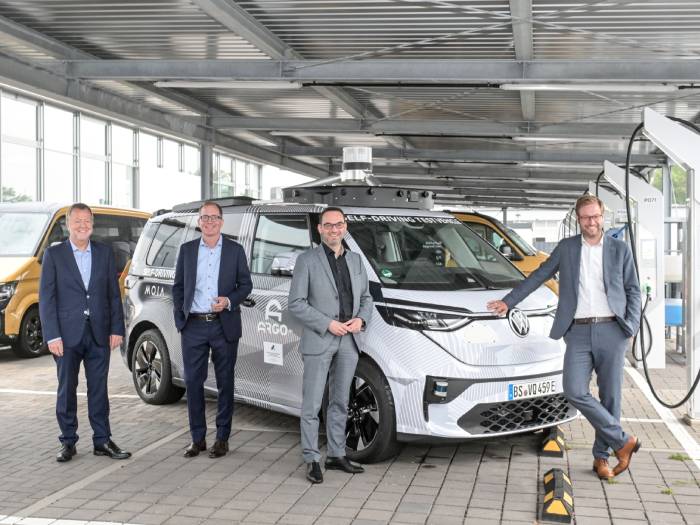All-electric and autonomous ride pooling: MOIA's vision of urban mobility
Thanks to the cooperation with Volkswagen Commercial Vehicles and ARGO AI, the first autonomous shuttles based on the new all-electric ID.BUZZ will be launched by 2025. The project will start in Hamburg.
MOIA, the Volkswagen Group's all-electric ride pooling service, is ready to take a further step, implementing autonomous driving on the ID.BUZZ AD. The goal of the project, developed by Volkswagen Commercial Vehicles, MOIA and Argo AI, is to launch an internationally scalable autonomous ride pooling system in Hamburg by 2025, starting.
“Autonomous driving is an important part of MOIA's business model: cities around the world seek to make their transportation more efficient and sustainable. Autonomous ride pooling has the potential to improve urban mobility and increase safety, making cities more liveable places”, said MOIA CEO Robert Henrich
Driverless ride pooling

Volkswagen Commercial Vehicles, MOIA and Argo AI are developing the components and processes needed to make driverless ride pooling operational in 2025, starting from the new all-electric ID.BUZZ AD. Argo AI is working on the self-driving system, consisting of a suite of hardware and software that provides a 360-degree awareness around the vehicle.
MOIA, on the other hand, is handling the mobility service part. “Volkswagen Group is investing in the future of mobility with AD, transforming itself from an automotive manufacturer to a software-driven mobility provider. This joint pilot project paves the way for self-driving mobility services. Here in Hamburg we are laying the foundation for the development and testing of technologies and operational processes along the value chain of a mobility service”, explained Christian Senger, Head of Autonomous Driving at Volkswagen Commercial Vehicles.
Mapping the city
Argo AI will start mapping the streets of the test area, creating three-dimensional maps. An activity in which Argo's autonomous test vehicles are driven in manual mode, operated by two trained drivers, throughout the city to annotate road infrastructure, local traffic laws, regulations and guidelines in the city. Every detail is important: the location and distances to traffic lights, road signs and bike lanes, for example.
After this, the testing and development phase will begin, in which the first autonomous vehicles with and without passengers will start to operate, to test the procedures and user experience of an automated ride pooling service. This includes testing all the tasks that are currently handled by the driver: checking that the people on board are the ones expected for the ride, their number, seat assignment and luggage storage. MOIA is developing the technology needed to perform these tasks. “We have extensive experience in fleet operations. Now, we are automating service processes such as driver-passenger interaction and fleet management”, Henrich added.
Testing in real road environments
The test area was selected on the basis of various criteria, but the main one was the presence of real conditions in which autonomous ride pooling could have the greatest impact. For this reason, districts with complex road situations and a lot of traffic challenges were chosen, a context in which the service could be particularly effective by supplementing local public transport.
Argo will apply the autonomous driving experience it has gained in eight complex urban areas in the United States over a period of five years to different European scenarios. The American company continuously tests its self-driving system, both in the labs and in simulated virtual environments, but also on two closed-circuit test tracks. “Operating on public roads is a privilege we take very seriously and safety remains our top priority. We believe that autonomous driving can improve mobility, for everyone who shares the road”, said Reinhard Stolle, Vice President of Argo's Munich office.
Extending fleets

The autonomous shuttles based on the future ID.BUZZ use a combination of lidar, radar and camera systems. Their interaction ensures that the surrounding environment is reliably detected, to a distance of 400 meters.
“Currently, we have several hundred MOIA vehicles on the road in Hamburg; if the fleet is extended to a thousand or more vehicles, the advantages of ride-pooling will become evident: increasing the mobility offer for users will reduce individual traffic, making public transport and cycling more efficient. For us, autonomous driving will be indispensable to expand fleets and significantly reduce the price for users”, Henrich explained. MOIA has been active since 2017 and over time has established itself as Europe's leading all-electric ride pooling system, with over 4 million passengers.
ITS World Congress
During the ITS World Congress 2021 last September, MOIA engaged the audience with the concept "Experiencing the future of mobility with us". Visitors were able to experience an interactive simulation through five scenarios, discovering them from different perspectives: user, city administration, operator.
“As a partner of cities and transport companies, we can make an important contribution to reducing individual traffic and using road infrastructure more efficiently” Henrich concluded.
Source: MOIA
VGI | Responsible OU: VP | Creation date: article date | Class 9.1
